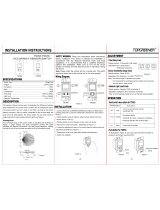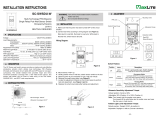Page is loading ...

Installation Instructions
Eaton’s Cooper Controls Business
203 Cooper Circle
Peachtree City, Georgia 30269
www.coopercontrol.com
Minor Motion, Ultrasonic
Major Motion, Ultrasonic
Maximum coverage area may
vary somewhat according to room
shape and the presence of obstacles.
The NEMA WD 7 Guide and robotic
method were utilized to verify
coverage patterns.
24’
(7.3 mm)
Minor Motion, IR
Major Motion, IR
20’
(6 mm)
8’
(2.4 mm)
8’
(2.4 mm)
24’
(7.3 mm)
20’
(6 mm)
0
10 ft
(3 mm)
12’
(3.7)
12’
(3.7)
6 ft
(1.7 mm)
15 ft
(4.6 mm)
24 ft
(7.3 mm)
50 ft
(15.3 mm)
Model # OAWC-DT-120W
Model # OAWC-DT-120W-R
Dual Technology Wall/Corner Mounted Low
Voltage Occupancy Sensor
• Readallinstructionsonbothsidesofthissheet
rst
• InstallinaccordancewithALLlocalcodes
• Forindooruseonly
• ForUsewithGreengateSwitchpacks&Systems
Only
• DonotrunanyGreengateLowVoltageWiringin
thesameconduitaspowerconductors
General Information
Technology:PassiveInfrared(PIR)andUltrasonic(US)
Power Requirements:
Input:
• 10-30VDCfromGreengateSwitchpackorGreengate
system.Maximumcurrentneededis25mApersensor
Output:
• OpencollectoroutputtoswitchuptotenGreengate
Switchpacks.BASwithIsolatedFormCRelay(-R
model)IsolatedFormCRelayRatings:1A30VDC/VAC
Time Delays:Self-Adjusting,15seconds/test(10minAuto)
orSelectable5,15,30minutes
Coverage:1200sq.ft.
Light Level Sensing:0to300foot-candles(-Rmodel)
Operating Environment:
• Temperature:32°F–104°F(0°C–40°C)
• RelativeHumidity:upto90%non-condensing
Housing:
• Mediumimpactinjectionmoldedhousing
• PolycarbonateresincomplieswithUL94V0
Size:4.4"x3.4"x2"(112mmx86.4mmx50.8mm)
LED Indicators:RedindicatesPIRdetection;Green
indicatesUltrasonicdetection
Specifications
Description
TheOAWC-DTWall/CornerMountLowVoltageOccupancySensorisaPassiveInfrared(PIR)andUltrasonic(US)motion
sensinglightingcontrol,usedforenergysavingsandconvenience.PIRisusedtoturnthelightsONandtheneitherorboth
technologiesareusedtokeepthelightsON.Whenmotionisdetected,thebluewireiselectronicallyconnectedtothered
wire,energizingtherelayintheswitchpacktoturnONtheload.Ifvacancyisdetected,thebluewireisdisconnectedfrom
thered,causingtherelaytoopenturningOFFtheload.Theredleadis10-30VDCsupply,theblackleadiscommonandthe
blueistherelaycontrol.
Thesensorincludesself-adaptivetechnologythatcontinuallyadjuststoconditionsbyadjustingsensitivityandtimedelay
inreal-time.
TheDaylightingfeature(-Rmodelonly)preventslightsfromturningONwhentheroomisadequatelyilluminatedby
naturallight.
TheWalk-ThroughfeaturemaximizesenergysavingsbynotleavingthelightsONaftermomentaryoccupancy.Thesensor
willswitchthelightsONwhenitdetectsapersonenteringthearea.Ifthesensordoesnotcontinuetodetectmotion30
secondsfollowingtheinitialactivation,itwillautomaticallygotoashorter2minutetimedelay.
InAutomaticONMode,thelightsturnONwhenapersonenterstheroom.InManualOnMode,thelightsareturnedON
byactivatingamomentaryswitch(model#GMDS-*)thatisconnectedtothesensor.Whenusedwith2levellighting
(-Rmodelonly),bi-levelAutomaticONcanbeachievedwhichallowsZone1tocomeONautomaticallyuponoccupancy.
Zone2doesnotcomeONunlesstheoccupantpressestheoptionalmomentaryswitch.
Location
Themaximumcoverageareamayvarysomewhataccordingtoroomshapeand
thepresenceofobstacles.Followthecoveragediagramconcerningmajorandminor
motioncoverage.Decreasetotalcoverageareaby15%for“soft”rooms(forexample,
heavydraperiesorheavycarpeting).Thesensormusthaveaclearviewofthearea
tobecontrolled.Thesensorwillnot“see”throughglass.Mountingheightshouldnot
exceed12feet.Optimummountingheightis10feet.Mountthesensorsothegrilles
facetheopenportionoftheroomandarenotfacinganearbywall,door,windowor
otherobstructingobject.Avoidpointingintohallways.Topreventfalseactivation,the
sensorshouldbemountedawayfromtheairsupplyductaminimumof4to6feet.
Mountingatxtureheightismosteffective.FortypicalplacementrefertoLocation
Diagram.
Installation
TheOAWC-DT-120Wcanbemountedtothewall,ceiling,junctionbox,orroundxturewithraceway.
Wiring
CAUTION: Before installing or performing any service on a Greengate system, the power MUST be turned OFF at the
branch circuit breaker. According to NEC 240-83(d), if the branch circuit breaker is used as the main switch for a
fluorescent lighting circuit, the circuit breaker should be marked “SWD”. All installations should be in compliance
with the National Electric Code and all state and local codes.
NOTE REGARDING COMPACT FLUORESCENT LAMPS: The life of some compact fluorescent lamps (CFLs) is shortened by
frequent automatic or manual switching. Check with CFL and ballast manufacturer to determine the effects of cycling.
1. MakesurepoweristurnedOFFatthebranchcircuitbreaker.
2. Wireunitsasshowninwiringdiagramsperapplicablevoltagerequirements.(Usetwist-onwireconnectorsforall
connections)CAPALLUNUSEDWIRELEADS.
3. Mountunittowall,ceiling,junctionboxorroundxturewithraceway.
4. TurnpowerbackONatthebranchcircuitbreakerandwaittwominutesfortheunittostabilize.
5. Makenecessaryadjustments.(SeeCheckoutandAdjustmentssection)
Occupancy Sensor Mounted to Wallboard
Occupancy Sensor Mounted to Round Fixture with Raceway
Occupancy Sensor Mounted to Octagon Box
Occupancy Sensor Mounted to Drop Ceiling
Location Diagram
Coverage
Occupancy Sensor Mounted to Octagon Box with Mud Ring
SENSOR WIRE LEAD LEGEND
Black (Common)
Red (10-30 VDC)
Blue (Control)
Yellow (Control)
Brown (Switch-Blue Lead Control)
Brown/White (Switch-Yellow Lead Control)
Sensor’s Isolated Relay
Orange (Normally Open)
Gray (Common)
Purple (Normally closed)
Yellow
Blue
Red
Black
Recommended Wire: 18-3 AWG stranded non-shielded
Brown/White
Brown
Gray
Purple
Orange
Optional Greengate GMDS Switch-
Blue Control Lead-Manual ON/OFF
To Additional Sensors.
Maximum of 5 sensors
per switchpack.
Switchpack
Blue
Load 1
White
**Hot
Blue
Hot
Neutral
Line
**Use Black Lead for 120 VAC
Use Orange Lead for 277 VAC
Cap Unused Lead
Black (Common)
Red (15 VDC)
Blue (Control)
One Sensor, One Switchpack
P/N 9850-000137-01

Eaton’s Cooper Controls Business
203 Cooper Circle
Peachtree City, Georgia 30269
www.coopercontrol.com
Printed in Malaysia
Warranties and Limitation of Liability
DIP Switch Settings
Troubleshooting
Pleaserefertowww.coopercontrol.comundertheLegalsectionforourtermsandconditions.
Checkout and Adjustment
Issue Possible Causes Suggestions
Lights
Will Not
Turn ON
automatically
WallSwitchOFF TurnWallSwitchON
Iflowvoltageswitchoptionisused,lights
mayhavebeenturned-offmanually
Presslow-voltageswitch
DaylightingFeatureEnabled
IfalllightsarerequiredtoturnONadjustDIP
Switch10and/ordaylightpotentiometer
Powerinterruption Checkincomingvoltageand/orwiring
Lights
Will Not
Turn ON
manually
DaylightingFeatureEnabled
IfalllightsarerequiredadjustDIPswitch
10and/ordaylightpotentiometer
Powerinterruption Checkincomingvoltageand/orwiring
If lights will still not turn ON, set sensor to override mode and call Technical Services at 1-800-553-3879
Lights
Will Not
Turn OFF
automatically
Override MakesuresensorisnotinOverrideMode(DIPSwitch8up)
UltrasonicSensitivitysetHigh
Lowersensitivitybyturninggreen
potentiometerCCWinsmalldecrements
Sensorinstalledclosetoanairvent
Sensorsshouldbeinstalledminimum4-6feetaway
fromanyairventandoutofpathofheavyairow
Sensorinstalledclosetoindirectlighting Sensorsshouldbemountedawayfromindirectlighting.
Self-adjust
Itmaybepossiblefortheunittohaveself-adjusted
thetimedelaytoa30minutedelay.Ifthelightsdo
notturnOFFafter30minutesfollownextstep
30MinuteDelay
Maximumtimedelayis30Minutes.CheckDIP
SwitchestoverifyDIPSwitchsettings.Iflightsdo
notturnOFFatthesettimedelay,checknextstep
PIRactivatedbyheat
sourceotherthanoccupant
MoveDIPSwitch5up
Bypass
Checkwiringtomakesuresensoror
switchpackarenotbypassed
Lights Will Not
Turn OFF
automatically
Override MakesuresensorisnotinOverrideMode(DIPSwitch8up)
If lights will still not turn OFF, call Technical Services at 1-800-553-3879
AdjustmentsshouldbemadewiththeHVACsystemON.Useonlyinsulatedtoolstomakeadjustments.
Self-Adjust
SensorisshippedintheSelf-AdjustMode.Thisappliestotimedelay,US,andPIRsensitivity.Inpreparationforthe
InstallerTest,thetimedelayissetto15seconds,afterthesensorisinstalled,poweredONandhasstabilized,theunitwill
time-out15secondsafterthelastmotiondetected.CoverageandsensitivitycanbeconrmedbywatchingtheGreen(US)
andRed(PIR)indicatorLEDsonthefrontofthesensor,whilemovingaroundtheroom.
1. WalkaroundtheroomandmonitorLEDs.LEDsshouldonlyturnONforonesecondwitheachmotion.(IfLEDsdonot
turnON,gotoInstallerAdjustments-SensitivityAdjustmentsSection)
2. Standstillsixtoeightfeetawayfromthesensorforveseconds.LEDsshouldnotturnON.(IfanyLEDturnsON,note
LEDandgo
toInstallerAdjustments–SensitivityAdjustmentsection)
3. Walkoutsidetheroomandwait15secondsforthelightstoturnOFF.(IflightsdonotturnOFFgotoInstaller
AdjustmentsSection)
4. Re-entertheroomtoactivatesensor.(IflightsdonotturnONgotoTroubleshootingSection)
5. TheunitwillremaininTestModefor5 minutesthenautomaticallyexitTestModeandgofor10min.TimeDelayUser
Modesetting.
Note:ToplaceintoTestMode,toggleDIPSwitch10outofitscurrentposition,wait3seconds,andthenbackintoitsoriginalposition.Toforce
into10minUserModemoveDipSwitches1and2down.(IfDIPSwitches1and2arealreadydown,toggleDIPSwitch1outofitscurrentposition,
wait3
seconds,andthenbacktoitsoriginalposition)WhileinTestMode,theLEDswillashonceper1/4second.
Installer Adjustments
Sensitivity Adjustments
Ultrasonic Sensitivity(GreenLED)–Usingasmallatheadscrewdriverturnthegreenpotentiometersothatthearrow
pointsU P.
1. Standindifferentareasoftheroomandwaveyourhands.
2. IftheGreenLEDdoesnotturnON,increasetheUSsensitivitybyturningthegreenpotentiometerclockwiseinsmall
increments.RepeatStep1.
3. Standstillsixtoeightfeetawayfromsensorforveseconds.LEDshouldnotturnON.
4. IfGreenLEDturnsONwithoutmotionorisconstantlyONdecreasetheUSsensitivitybyturningthegreen
potentiometercounter-clock-wiseinsmalldecrements.RepeatStep3.
Hot
Neutral
Line
Load 1
Black
Red
Blue
Purple
Gray
Orange
Switchpack
Blue
Blue
**Hot
**Use Black Lead for 120VAC
Use Orange Lead for 277VAC
Cap Unused Lead
White
Hot
Neutral
Line
Load 2
Switchpack
Blue
Blue
**Hot
**Use Black Lead for 120VAC
Use Orange Lead for 277VAC
Cap Unused Lead
White
Yellow
Brown
Brown/White
Optional Greengate GMDS Switch-
Blue Control Lead- Manual on/off
Red (15VDC)
Black(Common)
Blue (Control)
SENSOR WIRE LEAD LEGEND
Black (Common)
Red (10-30VDC)
Blue (Control)
Yellow (Control)
Brown (Switch-Blue Lead Control)
Brown/White(Switch-Yellow Lead Control)
Sensor's Isolated Relay
Orange (Normally Open)
Gray (Common)
Purple (Normally Closed)
Red (15VDC)
Black(Common)
Blue (Control)
To Additional Switchpacks
10 switchpacks Maximum
Power Pack One
Power Pack Two
(-R model only)
(-R model only)
Time Delay Activation Activation PIR Sensitivity Walk-Through Mode LEDs Override Daylighting ModeLighting Sweep
DIP Switch
12345678910
PIR Sensitivity
1. Standindifferentareasoftheroomandwaveyourhands.
2. IftheRedLEDdoesnotturnON,checkforanyobstructions.
3. Standstillsixtoeightfeetawayfromsensorforveseconds.LEDshouldnotturnON.
4. IfRedLEDturnsONwithoutmotionorisconstantlyONadjustPIRsensitivityto50%bymovingDIPswitch5U P.
Field-of-view outside the space
1. AdjustPIRsensitivityto50%bymovingDIPswitch5U P.
2. AdjustUltrasonicSensitivity.
Daylight Adjustments (-R model only)
Ifthisfeatureisnotneeded,leavethelightlevelatmaximum(fullyclockwise).
TheDaylightingfeaturepreventsthelightsfromturningONwhentheroomisadequatelyilluminatedbynaturallight.Ifthere
isenoughlightintheroomregardlessofoccupancy,thesensorwillholdthelightsOFF.Ifthereisnotenoughlightintheroom,
thesensorwillallowthelightstoturnONwhenoccupied.
Full and Half Logic Modes(SeeDIPswitchlegend):
InbothFullandHalfLogicmodes,lightsconnectedtotheyellowcontrolleadwillnotturnONuponoccupancyactivation,
shouldtheambientlightlevelexceedthepresetfoot-candlelevel.
After activation:
FullLogicMode–shouldtheambientlightlevelexceedthepresetfoot-candlelevel,thelightsconnected
totheyellow
controlleadwillturnOFF.ThelightswillremainOFF,untiltheambientlightlevelfallsbelowthesetpoint.
HalfLogicMode–theoutputstateoftheyellowcontrolleadwillnotchangewithambientlightchanges,afteroccupancy
activation.Iftheamountofnaturallightavailablerisesabovethesetpoint,thedaylightsensorwillnotturnthelightsOFFwhile
occupancyisbeingdetected.
Note:Setthelightlevelwhentheambientlightisatthelevelwherenoarticiallightisneeded.Inorderforthisfeatureto
function,theyellowcontrolleadmustbewired.
1. WiththeloadON,putthesensorintoTestMode.ToplaceintoTestMode,toggleDIPswitch10outofitscurrentposition,
wait3secondsandthenbackintoitsoriginalposition.
2. SetDIPswitch10toFullorHalfLogicMode.
3. Setthelightleveltominimum(fullyCCW).
4. Leavetheroomandletthesensortime-outsolightsareOFF.EnterthespaceandlightsshouldremainOFF.
5. MakesurenottoblockthesensorfromthedaylightsourceandadjustthelightlevelpotentiometerCWinsmallincrements
untilthelightsare
ON.(Pause5secondsbetweeneachadjustment)
6. OncethelightsareON,theloadconnectedtothesensorwillnotturnONiflightlevelsareabovethecurrentillumination.
Time Delay Adjustments
PeoplewhoremainverystillforlongperiodsoftimemayneedalongerTimeDelaythanthedefaultsettingof10minutes.
AslongasAutoisenabled,thesensorwillrespondtoeachpairoffalse-OFFswithnonormalOFFinbetween,byalternately
makingslightadjustmentstoeithertimedelay(by2minuteincrements)orsensitivity,sothereshouldbenoneedformanual
adjustment.Ifmanualadjustmentisdesired,refertoTimeDelaysettingsinDIPswitchlegend.
ResetsensortimedelaytofactorysettingsbymovingDIPswitches1and2down.(IfDIPswitches1and2arealreadydown,
toggleDIPswitch1outofitscurrentposition,wait3seconds,andthenbacktoitsoriginalposition)
Automatic Mode
InAutomaticONMode,thelightsturnONwhenapersonenterstheroom.Ifoptionalmomentarylowvoltageswitchesare
usedalongwithAutomaticONMode,activatingtheswitch(es)whiletheloadisONturnstheloadOFF.Whentheloadisturned
OFFmanually,
aslongasthesensorcontinuestodetectoccupancytheloadsstayOFF.Afterthetimedelayexpires,thelights
stayOFFandthesensorgoesbacktoAutomaticONMode.Forwiringinformationfortheoptionalmomentarylowvoltage
switch(es),pleaseseethewiringsectionoftheinstallationinstructions.
Manual Mode
InManualONMode,theoptionalmomentarylowvoltageswitch(es)isrequiredtoturntheload(s)ON.Onceactivatedthe
sensorwillmaintainthelightsONuntilmotionceasesandthetimedelayexpires.WhiletheroomisoccupiedtheBASrelay
remainsactive.Afterthetimedelayexpires,theload(s)willautomaticallybeturnedOFFandtheswitch(es)mustbeusedtoturn
theload(s)ONunlessthereismotiondetectedwithinthe10secondre-triggerperiod.
Lighting Sweep Option
Ifselected,thisDIPswitchoptionforcesaninitial60seconddelayupon“power-up”topreventfalseactivationinbuildings
withcomputercontrolsystems.
1. MoveDIPswitch9U P.
Override
TheOverridesettingallowsthelightstoremainONintheunlikelyeventofsensorfailure.
1. MoveDIPswitch8U P.
WhileinOverrideMode,theoptionallowvoltagemomentaryswitch(es)willtogglethelightingload(s).
One Sensor, Multiple Switchpacks
/


